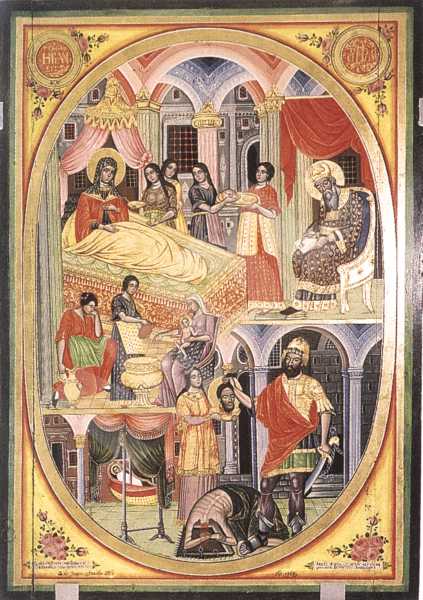The Nativity of St. John the Forerunner and His Beheading
Type:
Icon
Period:
1860 year
Dimmensions (cm):
76.5
/ 62
/ 3.5
Location
Country: Bulgaria
Province: Blagoevgrad
Village: Leshko
Church: St. Archangel Michael
Source
Country: Bulgaria
Province: Blagoevgrad
Village: Leshko
Church: St. Archangel Michael
Description
The painter has treated the theme traditionally, representing two events in the saint's life on the same icon: the nativity of Saint John the Baptist and his beheading. In the icon's upper part he has painted Saint Elizabeth, seated on a plank-bed. Facing her, on the icon's right-hand side, is the seated prophet Zacharias. The scene is laid against the background of the interior of a rich man's room with columns, arches, canopies and Baroque ornaments on the walls. Standing in the composition's middle row are three female figures around a font, wherein the newly-born John had been bathed, and are swaddling him. The composition is developed in an almost illustrative manner, the painter including a great number of the household objects, the dresses and the interior of the house of the Revival Period. Painted in the composition's lower part is the scene of the beheading of Saint John the Baptist. In the foreground is the daughter of Herod, carrying a tray. A soldier in full armor and sword in hand is laying the freshly cut-off head of the Prophet in the tray. The composition is enclosed in an elliptic gilded frame. There are indicative inscriptions in two medallions up above the icon and ornaments in the two lower corners.
Iconographical technique: Tempera
A distemper painting with gilding, velaturas and in the "probaster" technique. The varnish cover is in several layers and forms a good "film" over the painting layer, which is the reason for the latter being well preserved.
Base material: Wood
The icon's base is made of two softwood panels, joined by means of two beams on their backs. The ground coat is of plaster, laid thinly and very evenly.
State, restoration traces and comments
There are no traces of any previous restorative interventions.


